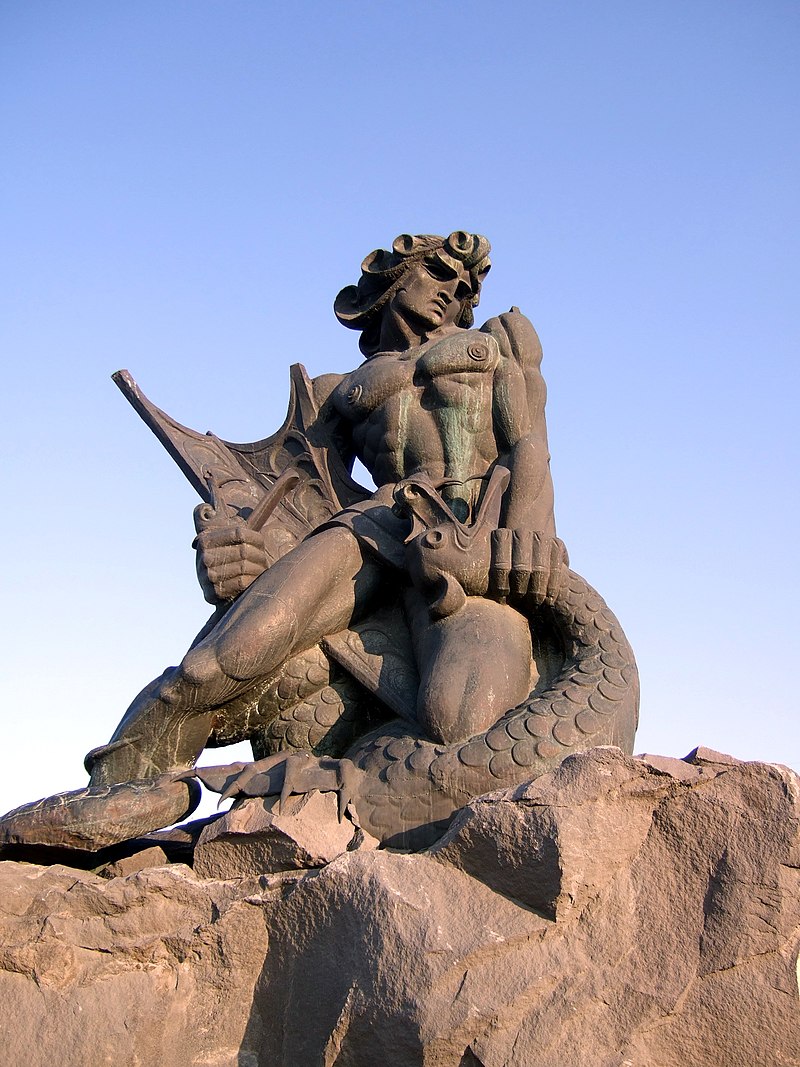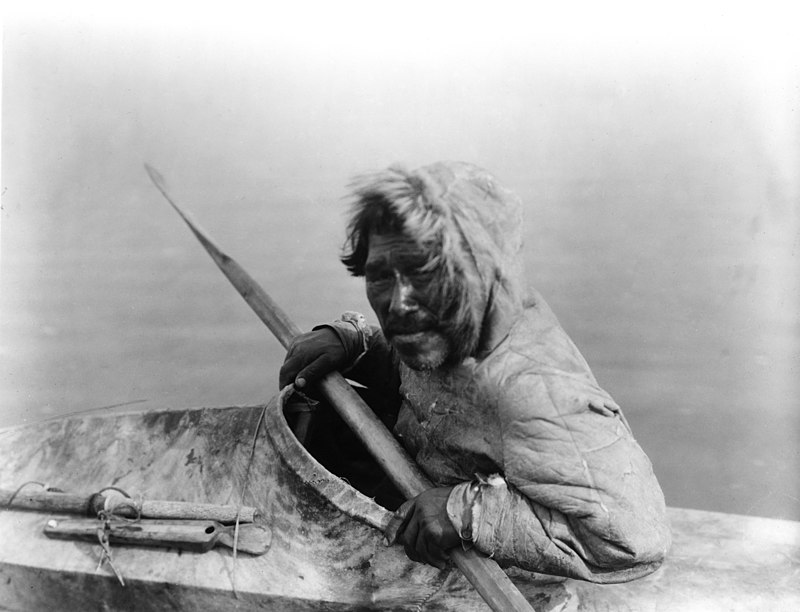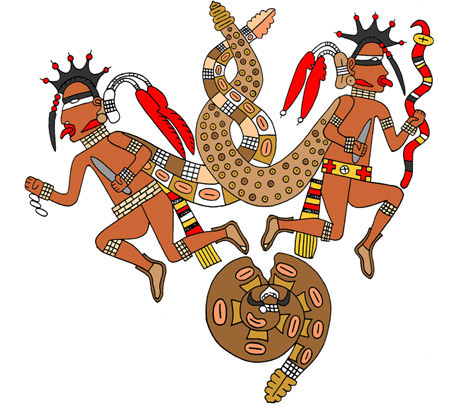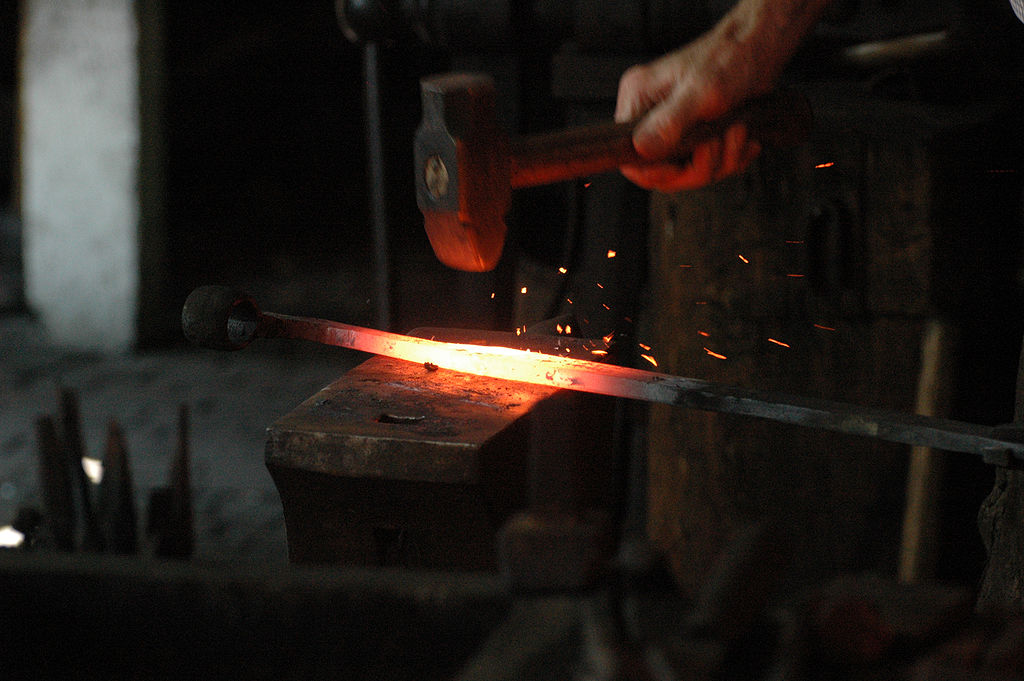
Before organized religions and written history, a people’s collective past consisted of stories, passed down by word of mouth, that kept the new generations linked to former generations and reinforced the worldview and values of that given society with each telling. One of the characters found in many of these tales holds a special importance and can be seen as the ideal member of the group or society of it’s origin. This figure is known as a culture hero and is usually associated with bringing large scale change through divine intervention or the discovery a life altering technology (calendars, agriculture, animal domestication). Sometimes these characters are more deity than mortal, but just as many fall more in line with the traditional trickster character and are very human in their appearance and demeanor. Below are seven examples of culture heroes from various cultures around the globe. Enjoy.
1. Bunjil, Australia

Our first culture hero hails from the aboriginal peoples of Australia. While there is a great amount of regional diversity in the telling of his exploits, Bunjil seems to be a common figure on much of the continent. Bunjil is a multi-faceted character, serving as both a creator deity and the founder of his people. Some stories describe him as a man much like an aboriginal chief, but others claim he is either part eagle hawk or can take the form of an eagle hawk. Bunjil, after creating the universe, married twice and had a son, Bineal, who is the embodiment of the rainbow. In one story, Bunjil is called down to help humanity after their incessant quarreling convinces the ocean that they need to be drowned. Bunjil agrees to help them, but only if they stop fighting and respected each others laws and customs. After the people agreed to do this, he walked out onto the water (Jesus-style) and raised his spear into the air (not Jesus style). The water stopped rising, and the people of Australia got their land back. In another story, Bunjil, for reasons I can’t seem to figure out, gets Crow, another deity, to unleash wind he has stored in a bag. The winds create a cyclone, but this is not enough for Bunjil who persuades him to open it further. Whe Crow does, the wind is so powerful it blows Bunjil and his family into the sky, fixing them there as constellations.
2. Finn McCool, Ireland

Whereas Bunjil stands above his people in the role of a god, Finn McCool represents a more down to earth brand of culture hero. Bastard son of an outlaw, Finn was condemned to death by his maternal grandfather and was whisked away to safety by his mother. He was raised by warriors in the secret forest of Sliabh Bladma and soon became a well respected mercenary for the local kings and war lords. Business was not stable though; as each of his successive patrons identified him as the bastard son of their former enemy, they turned him away. Without any job prospects, Finn does what any Celtic lad without work does; he studies with a magical poet who has grown wise from his magic, hazelnut diet. During Finn’s seven years of study with the poet, Finnegas, he helps the little man track the Salmon of Wisdom that, when caught, granted the man who ate it all the knowledge in the world. Eventually Finn catches it and while cooking it for his teacher, burns his thumbs and gets some of the fish juice in his mouth, giving him the fish’s gift. With his new found wisdom, Finn returns to the world of men and decides to help his people. A fire breathing wizard, you know the type, had been putting the local towns to sleep with his magic before incinerating them mercilessly with his fire breath. Finn decides to help, staying in the town until the wizard’s magic begins lulling people to sleep, and uses the red hot point of his spear tip to keep burning himself to stay awake. Weathering the effects of the spell, he awaits the wizards arrival, surprises him and kills him. This helps Finn win over his father’s old enemies and assume his roll as head of his people. Most other tales concern Finn’s wives, who have a bad habit of being turned into animals and getting lost. As the legend goes, Finn never died, but is simply hibernating in a cave, surrounded by his men, so that if Ireland ever needs his help, he can rush to their aid. All well and good, but maybe it might be nice to use some of that free time to find those lost wives from back in the day. Just a thought.
3. Yellow Emperor, China

The Yellow Emperor of China is a pseudo-historical figure whose importance and role in Chinese society has undergone multiple transformations since ancient times. Chinese history is understood differently from Western history in so much as the mythic past is respected as part of the nations literal history in many circles. The mythology states that ancient China was ruled by three legendary sovereigns and five emperors and that of these eight powerful men, the Yellow Emperor was the most powerful and influential. Going by the name Huangdi, the pseudo-historical emperor has been given reign dates of around 2697-2597BCE, and is known as the creator of China’s centralized state , a patron of the arts and author of several extant ancient Chinese texts. He was apparently born outside of Shandong and migrated to an area known as Zhuolu where he tamed the wild beasts of the area before going on to teach the nomadic tribesmen of the area how to build towns, promote agriculture and use the tamed the animals to improve the land. He also gave them many inventions quintessential to civilized living; clothing, calendars, wheeled carts, math, writing and fishing boats. After consolidating his rule, he defeats monsters and rival kings to unite China under his banner. His legend ends after he meets two mythical beasts, and, after speaking with them, he dies.
Despite this ludicrously long reign and obvious supernatural elements, until the 1920s the Yellow Emperor was considered to be a more or less historical figure and only after modern Chinese scholars (of the aptly named Doubting Antiquity School) began to dig deeper did his status come into question. Their current theory is that these mythological kings and sages began as gods, but during the Warring States period were converted into mythic kings that fit better into the worldview of that era. During the Qing dynasty, the Han people rallied around the image of the Yellow Emperor as an ancestral figure and only in early 20th century did he become a nation wide symbol. The rise of communism saw the cult of the emperor suppressed for a time, but in the 1980s the government embraced him as a symbol of Chinese unity and common heritage. The Yellow Emperor is a culture hero that has it all; cosmic presence, an inventors mind and, most importantly of all, a link to the common past of the people who have kept his story alive for millennia.
4. Red Horn, Ho-Chunk

Variations of Red Horn can be found in various Native American cultures, but for this entry we will focus on the Ho-Chunk version. Red Horn is one of the sons of the Earthmaker and the legends state that he was sent by his father to rescue mankind. His adventures are told in a series of stories known as the Red Horn Cycle. In one popular story, Red Horn and his friends Turtle and the Thunderbird are made aware of a race of giants that have been preying upon the area’s human population. Red Horn and company decide to challenge them to a three event competition. One of the oddest features that Red Horn posses are a pair of faces on his earlobes and during the first event, a lacrosse match, his earlobe’s make funny faces at the giants best player and she cannot focus. This helps Red Horn’s team win and gives them the momentum to sweep the giants. Furious the giants challenge them to a wrestling contest, and Red Horn foolishly accepts. This outing doesn’t go as planned and they lose two out of three matches and the giants kill them. Red Horn’s wives were with child at the time of his death and their two sons, one with faces where his nipples should have been, eventually decide to avenge their father and his friends. They steal their loved ones skulls, that have been put on display since their defeat and execution, and escape, killing almost all of the giants in the process. Returning the heads to their mothers, they beg the women to sleep next to the heads, to which the women reasonably reply, ‘No, why would I sleep next to my dead husband’s skull?’ The skulls are given a bed at the center of the lodge and, lo and behold, in the morning all three men had come back to life. What Red Horn does after his resurrection is unclear, but his popularity with the Ho-Chunk and their neighbors suggests that a wealth of stories exist for anyone who cares to find out.
5. Kiviuq, Inuit

I’ll be upfront, I don’t like Kiviuq. This culture hero is of Inuit origin and his stories follow his journey from place to place in his kayak. Some of Kiviuq’s adventures are harmless enough. In one he befriends a boy who is mocked and tormented by his fellow villagers. The boy’s grandmother grows tired of the boy’s treatment and turns him into a seal. The boy, in seal form, lures the villagers out into the sea where the grandmother conjures a storm, drowning them. The only one permitted to survive is Kiviuq. Others are strange and seem to have no allegorical value. For instance, in one episode Kiviuq comes across a witch who is scraping a human skin she took from some unfortunate traveler. When Kiviuq stands beside her, she thinks his shadow is caused by her heavy eyelids so, naturally, she cuts them off and eats them. Kiviuq decides this woman is probably not friend material and paddles on. The worst stories though seem to weave domestic violence and bestiality into one awful package. I won’t go into detail since I’d like you to come back and read something else on this site, but in one story he murders his two unfaithful wives in ways that make the SAW franchise seem tame and in another he forces a fox to marry him and the other woodland animals begin to feel bad for her since Kiviuq is pimping her out to wolverines (you read that correctly). Kiviuq has supposedly led many lives, but is currently in his last. The Inuit lore states that during this time Kiviuq will slowly turn to stone. When he is finally solid rock, the world will end and, at the very least, the woods will get a little safer for foxes everywhere.
6. Maya Hero Twins

Part of one of the oldest Mayan myths known today, the Mayan Hero Twins interact not only with the Mayan people, but the world of the dead, Xibalba. Their mother was from this land of the dead and conceived the boys when the severed head of their father spat in the woman’s hand. The boys had a rough upbringing, with family members trying to cheat and murder them during their formative years. Despite these constant attacks and degradations, the boys keep a good attitude and as they age they handle these trials with increasing ease. In one story, their older brothers, who had once placed them on anthills as infants in hopes of killing them, are tricked into climbing trees that the twins magically cause to grow, trapping their siblings high in the air. The brothers are then turned into monkeys and they flee in shame, never to be seen again. In a story from their adulthood, the brothers are asked by the gods to kill a false god, Seven Macaw, who was gaining a following. Even after one of the brothers loses an arm, they succeed in tricking Seven Macaw, stealing his teeth and eyes, and retrieving the arm they had lost earlier. Seven Macaw died of shame, but his sons took up his followers and continued to cause trouble. The Twins handled them both, burying them deep below the earth so that they could not plague the world again. Their final adventure happens when the boys annoy the gods of the underworld, Xibalba, by loudly playing the traditional basketball type game made famous by the Mayans and Aztecs. The lords of the underworld make them undergo a series of tests that the boys conquer, shaming the lords into cheating them and killing them despite their victories. The boys come back to life and, donning disguises, get revenge on the lords of death by killing some of their number and forcing the others to confess their crimes. The twins leave the underworld crippled and tell the men on the surface to cease making offers to the lords of the dead. The boys, having defeated the lords of the underworld, ascend into the sky becoming the sun and the moon.
7. Kave, Persian

Much of Persian folklore ad history is concerned with the defense from, and ousting of, foreign invaders. It is no surprise then that Kave is a revolutionary character, responsible for keeping Persia in the hands of Persians during a time of strife and invasion. The story goes that Kave was just a peaceful blacksmith when the foreign warlord Zahak invaded Persia. Zahak apparently had an army of monsters alongside his troops because what draws Kave into the fight is the death of his sons, who are killed by Zahak’s serpents. Kave rallied the people under a banner made from his spear and his leather smithing apron and encourages the true leader of Persia, Fereydun, to lead his people into battle. Before they go though, he adds a little bling to Kave’s apron and this symbol, the jewels combined with the spear and apron, is still part of the Iranian flag symbology today. With Persia’s true leader, Fereydun, alongside him, Kave and his rebels deposed Zahak and drove his forces from their land. With Persian rule restored, Kave could return to his old life, though his banner remains an important rallying cry for his people to this day.
Thanks for reading! If you liked this list check out 9 Strange Yokai from Japanese Folklore, 9 Gods of the Egyptian Pantheon or 9 Obscure Native American Mythological Figures. You can also check out our Archives and see a full list of all of our content.

4 thoughts on “7 Culture Heroes from Around the World”